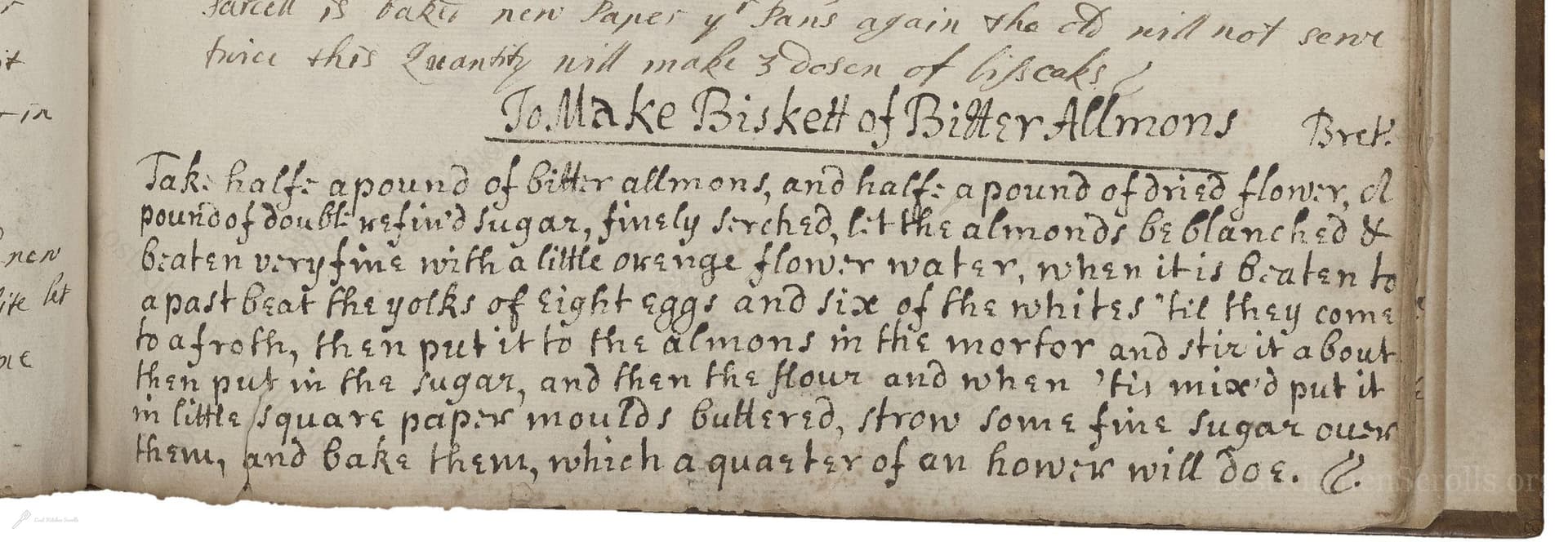To Make Biskett Of Bitter Allmons
From the treasured pages of Receipts in cookery and medicine 1700
Unknown Author

To Make Biskett Of Bitter Allmons
"Take halfe a pound of bitter allmons, and halfe a pound of dried flower, & a pound of double refin'd sugar, finely sirched, let the allmonds be blanched & beaten very fine with a little orenge flower water, when it is beaten to a past beat the yolks of eight eggs and six of the whites 'til they come to a froth, then put it to the almons in the morter and stir it about then put in the sugar, and then the flower and when 'tis mix'd put it in little square paper moulds butterrid, strow some fine sugar over them, and bake them, which a quarter of an hower will doe. &c."
Note on the Original Text
The recipe is written in the verbose, free-flowing style of late 17th- to early 18th-century manuscript cookery books, eschewing precise timings, temperatures, or measurements beyond household weights. Spellings such as 'allmons' (almonds), 'sirched' (sifted), 'flower' (flour), and 'hower' (hour) reflect the lack of standardized spelling at the time. Directions are continuous and conversational, expecting the cook’s prior knowledge of kitchen basics. There is an implicit trust in intuition, with measurements like 'let the almonds be blanched' and instructions to bake 'a quarter of an hower', without specifying oven heat.

Title
Receipts in cookery and medicine 1700 (1700)
You can also click the book image above to peruse the original tome
Writer
Unknown
Era
1700
Publisher
Unknown
Background
Step into the kitchen of the early 18th century, where this charming culinary manuscript tempts tastebuds with recipes and secrets from a bygone era. A delicious journey for both the curious cook and the history lover.
Kindly made available by
Folger Shakespeare Library
This recipe hails from early 18th-century England, circa 1700. At this time, almond-based sweets and biscuits were a sign of extravagance, often seen at the tables of the wealthy. Bitter almonds, richer in flavor (and, in historical contexts, perilously unregulated for toxicity), were favoured for their intense nutty note. Recipes like this reflect both the influence of French and Mediterranean confectionery and the increased availability of refined sugar in England's evolving culinary culture.

The cook would have used a large sturdy mortar and pestle to pound the blanched almonds into a paste, employing patience and elbow grease. Eggs were whisked by hand with a bundle of thin twigs or a fork until frothy. Ingredients were combined in large earthenware or wooden bowls. The mixture would then be spooned or piped into paper moulds (hand-cut parchment squares) brushed with butter, and the biscuits baked in a wood-fired oven managed by careful observation and intuition rather than thermostats or timers.
Prep Time
25 mins
Cook Time
15 mins
Servings
16
We've done our best to adapt this historical recipe for modern kitchens, but some details may still need refinement. We warmly welcome feedback from fellow cooks and culinary historians — your insights support the entire community!
Ingredients
- 8 oz bitter almonds (or substitute with sweet almonds + almond extract)
- 8 oz plain flour (dried, sifted)
- 1 lb caster sugar (double refined, finely sieved)
- Orange flower water, a few teaspoons
- 8 egg yolks
- 6 egg whites
- Butter, for moulds
- Extra caster sugar, for sprinkling
Instructions
- To make these delectable Bitter Almond Biscuits, start by finely blanching and grinding 8 oz of bitter almonds (or regular almonds with a few drops of almond extract if bitter almonds are unavailable) with a splash of orange flower water.
- Beat together 8 egg yolks and 6 egg whites until frothy.
- In a bowl, mix the ground almonds and egg mixture, then gently fold in 1 lb of finely sifted caster sugar, followed by 8 oz of plain flour.
- Prepare small square paper cases or line a mini-loaf tin with buttered baking paper, then spoon the bater into the moulds.
- Sprinkle extra caster sugar over the tops.
- Bake at 350°F for around 15 minutes, or until just golden on top.
- Allow to cool before serving – crisp on the outside, soft insde.
Estimated Calories
200 per serving
Cooking Estimates
Preparation takes about 25 minutes, including grinding the almonds, beating eggs, and mixing ingredients. Baking takes about 15 minutes. Each batch makes 16 biscuits, and each biscuit contains about 200 calories.
As noted above, we have made our best effort to translate and adapt this historical recipe for modern kitchens, taking into account ingredients nowadays, cooking techniques, measurements, and so on. However, historical recipes often contain assumptions that require interpretation.
We'd love for anyone to help improve these adaptations. Community contributions are highly welcome. If you have suggestions, corrections, or cooking tips based on your experience with this recipe, please share them below.
Join the Discussion
Rate This Recipe
Dietary Preference
Culinary Technique
Occasions

Den Bockfisch In Einer Fleisch Suppen Zu Kochen
This recipe hails from a German manuscript cookbook compiled in 1696, a time whe...

Die Grieß Nudlen Zumachen
This recipe comes from a rather mysterious manuscript cookbook, penned anonymous...

Ein Boudain
This recipe comes from an anonymous German-language manuscript cookbook from 169...

Ein Gesaltzen Citroni
This recipe, dating from 1696, comes from an extensive anonymous German cookbook...
Browse our complete collection of time-honored recipes



